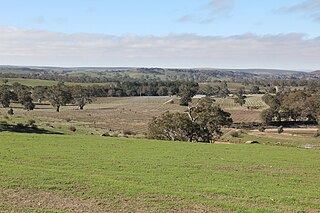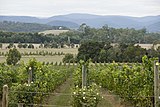Related Research Articles

The Clare Valley wine region is one of Australia's oldest wine regions, best known for Riesling wines. It lies in the Mid North of South Australia, approximately 142 km north of Adelaide. The valley runs north-south, with Horrocks Highway as the main thoroughfare.

The Goulburn Valley is a sub-region, part of the Hume region of the Australian state of Victoria. The sub-region consists of those areas in the catchment of the Goulburn River and other nearby streams, and is part of the Murray-Darling Basin. The Goulburn Valley is bordered on the south by the Great Dividing Range and to the north by the Murray River, the state border with New South Wales. The sub-region is one of Australia's most productive and intensively farmed areas and is predominantly irrigated.

Nagambie is a town in the Goulburn Valley region of Victoria, Australia. The city is on the Goulburn Valley Freeway north of Seymour and in the Shire of Strathbogie. As of 2021 census, Nagambie had a population of 2,254.

The Australian wine industry is one of the world's largest exporters of wine, with approximately 800 million out of the 1.2 to 1.3 billion litres produced annually exported to overseas markets. The wine industry is a significant contributor to the Australian economy through production, employment, export, and tourism.

New Zealand wine is produced in several of its distinct winegrowing regions. As an island country in the South Pacific Ocean, New Zealand has a largely maritime climate, although its elongated geography produces considerable regional variation from north to south. Like many other New World wines, New Zealand wine is usually produced and labelled as single varietal wines, or if blended, winemakers list the varietal components on the label. New Zealand is best known for its Marlborough Sauvignon Blanc, and more recently its dense, concentrated Pinot Noir from Marlborough, Martinborough and Central Otago.
Tahbilk Winery is a historic Australian winery with National Trust certification. It is located 120 km (75 mi) north of Melbourne between the townships of Seymour and Nagambie in the Nagambie Lakes a sub region of Goulburn Valley Wine Region. It was established in 1860, and is the oldest family-owned winery and vineyard in Victoria. The winery is part of Australia's First Families of Wine, a prominent Australian wine alliance.

The South Australian wine industry is responsible for more than half the production of all Australian wine. South Australia has a vast diversity in geography and climate which allows the state to be able to produce a range of grape varieties–from the cool climate Riesling variety in the Clare Valley wine region to the big, full bodied Shiraz wines of the Barossa Valley.

Victorian wine is wine made in the Australian state of Victoria. With over 600 wineries, Victoria has more wine producers than any other Australian wine-producing state but ranks third in overall wine production due to the lack of a mass bulk wine-producing area like South Australia's Riverland and New South Wales's Riverina. Viticulture has existed in Victoria since the 19th century and experienced a high point in the 1890s when the region produced more than half of all wine produced in Australia. The phylloxera epidemic that soon followed took a hard toll on the Victoria wine industry which did not fully recover till the 1950s.
The Alpine Valleys is an Australian wine region on the western slopes of the Victorian Alps in northeast Victoria. It was registered as an Australian Geographical Indication on 29 November 1999 It is bounded to the west by the King Valley and to the north by the Beechworth wine region. The area is distinctly cooler in climate than some of the other northeast wine regions like Rutherglen. The Alpine Valleys produce grapes primarily for table wine production.

Western Australian wine refers to wine produced in Australia's largest state, Western Australia. Although the state extends across the western third of the continent, its wine regions are almost entirely situated in the cooler climate of its south-western tip. Western Australia produces less than 5% of the country's wine output, but in quality terms it is very much near the top, winning 30 percent of the country's medals.

The Hunter Valley is one of Australia's wine regions. Located in the state of New South Wales and first cultivated in the early 19th century, it was one of the first Australian wine regions. As well as Hunter Valley Sémillon, the region produces wine from a variety of grapes including Shiraz, Chardonnay, Cabernet Sauvignon and Verdelho.
Rutherglen is a wine-producing area around the town of Rutherglen in North East Victoria zone of the state of Victoria in Australia. The area is particularly noted for its sweet fortified wines.

Eden Valley wine region is a wine region located in South Australia immediately north of the capital city of Adelaide which covers an area in the Mount Lofty Ranges extending from Truro in the north to just south of Springton in the south. The region received appellation as an Australian Geographical Indication in 1997 and as of 2014, it is represented by at least 36 wineries.
Hastings River is an Australian Geographical Indication for a wine region in the Northern Rivers area of New South Wales around the Hastings River near Wauchope and Port Macquarie.The region is within 25 kilometres (16 mi) of the east coast of Australia, between the Pacific Ocean and the Great Dividing Range.
Mudgee is a wine region and Australian Geographical Indication in the Central Ranges zone in the Australian state of New South Wales. It is named for the town of Mudgee.

Goulburn Valley wine region is a wine region in the state of Victoria in Australia. It is part of the Central Victoria zone and roughly corresponds to the Goulburn Valley tourist and government region.
Tabilk is a small rural area located about 90 minutes north of Melbourne. The 2016 census recorded that 131 people lived in the area. The closest major towns are Nagambie, Avenel and Seymour (About 25–30 minutes south-west of Tabilk. Tabilk is mostly a farm town with no shops.

The Marlborough wine region is by far New Zealand's largest, accounting for three quarters of the country's wine production, 70% of its vineyard area and 85% of its wine exports. A Geographical Indication in the north-east of the South Island, it covers the entire Marlborough District and the Kaikōura District of the Canterbury Region, but in practice the vineyards are concentrated around the Blenheim and Seddon townships. Internationally, Marlborough Sauvignon Blanc is recognised as world class; wine writers such as Oz Clarke and George Taber have described it as the best in the world.
The Sunbury wine region is an Australian Geographical Indication for wine made from grapes grown in a region surrounding the town of Sunbury northwest of Melbourne in the Australian state of Victoria. It is one of five regions in the Port Philip zone surrounding Melbourne. The wine region covers suburbs and inner rural areas in the northwestern sector of the Melbourne urban area, extending as far west as Bacchus Marsh and northeast to Beveridge on the Hume Highway.
Upper Goulburn is a wine region in the Australian state of Victoria. It was designated as an Australian Geographical Indication on 14 October 2003. It is located north of the Yarra Valley wine region on slopes that drain to the north and west into the Goulburn River and eventually the Murray River. To its north are the wine regions of Goulburn Valley, Strathbogie Ranges and King Valley.
References
- ↑ "Nagambie Lakes Geographical Indication". Register of Protected GIs and Other Terms. Wine Australia . Retrieved 14 September 2020.
- 1 2 3 4 "Nagambie Lakes, Victoria". Halliday Wine Companion. Retrieved 14 September 2020.}
- ↑ "Geographical indications". Register of Protected GIs and Other Terms. Wine Australia . Retrieved 14 September 2020.
- ↑ "Goulburn Valley". Discover Australian Wine. Wine Australia, Australian Grape and Wine Authority . Retrieved 14 September 2020.
- ↑ "Nagambie Lakes Wine Region in Central Victoria". Vinodiversity. Retrieved 14 September 2020.
- ↑ "Nagambie Lakes Wine". Wine-searcher. 8 March 2015. Retrieved 14 September 2020.
